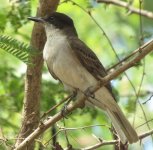Larry Sweetland
Formerly 'Larry Wheatland'
Vieques
I'd suggest to him just have two 15 minute tea beaks at work to cram it in til you have to stop!
We first laid eyes on the island of Vieques early in the trip, a distant blob of land seen out to sea off Punta Santiago. 'Hmmm, so that must be Mt Pirata then' I thought of the pointy bit. Vieques is about 40km long but very thin. Mt Pirata is in the far western end, and the place we'd booked to stay was a small beach town on the south coast, but not that far east from Mt Pirata as the dove flies. Vieques was until recently mostly an American military base, with big areas of it now turned over to natural areas (US Fish and Wildlife Service?). The island is best known as as a tourist destination because of it's bioluminescent bays, quiet beautiful beaches, and snorkelling potential.
The 2 hour ferry journey was disappointing birdwise, as I'd hoped to pick up something we hadn't seen on the trip yet. It was in fact dead except for a single Royal Tern as we pulled into port. We then got a cheap communal taxi over the hilly spine of the island to Esperanza. This was a rough and ready tropical experience on very bad roads in a very shaky old van with friendly excitable locals. It was very hot. Brilliant.
The beach bars and restaurants and town were lovely, and from our balcony at Casa de Kathy we could see Antillean Crested Hummingbirds, Green-throated Carib, Adelaide's Warbler, displaying Antillean Nighthawks, Puerto Rican Woodpecker etc. The nearby beach had settling Least Terns, Yellow-crowned Night Heron, Magnificent Frigatebirds, Brown Pelicans, American Oystercatcher, Semi-palmated Sandpiper, Caribbean Martin and a few Brown Boobies settling (breeding?) on the islet opposite. It was pretty quiet down on the beach, and we found a spot where we could swim, see all these birds, and settle in the shade, sharing the area just with a family in a 4x4 a little up the beach blasting out some classy samba band with a ludicrously o.t.t. bass player, at just the right volume. It was the Caribbean, and it felt like holiday. The scrub behind the beach had the 2 hummers, Loggerhead Kingbird, Adelaide's Warbler, Common Ground, Zenaida and White-winged Doves etc.
I was looking forward to trying to work out how to start looking for quail doves whilst here, all 3 Puero Rican species being on this island...
Now I've got to go off and be in a field til monday
So did you get it ?
I reckon John Grisham could learn a thing or two from you about "now read on" paragraphs at the end of chapters!
Cheers
Mike
I'd suggest to him just have two 15 minute tea beaks at work to cram it in til you have to stop!
We first laid eyes on the island of Vieques early in the trip, a distant blob of land seen out to sea off Punta Santiago. 'Hmmm, so that must be Mt Pirata then' I thought of the pointy bit. Vieques is about 40km long but very thin. Mt Pirata is in the far western end, and the place we'd booked to stay was a small beach town on the south coast, but not that far east from Mt Pirata as the dove flies. Vieques was until recently mostly an American military base, with big areas of it now turned over to natural areas (US Fish and Wildlife Service?). The island is best known as as a tourist destination because of it's bioluminescent bays, quiet beautiful beaches, and snorkelling potential.
The 2 hour ferry journey was disappointing birdwise, as I'd hoped to pick up something we hadn't seen on the trip yet. It was in fact dead except for a single Royal Tern as we pulled into port. We then got a cheap communal taxi over the hilly spine of the island to Esperanza. This was a rough and ready tropical experience on very bad roads in a very shaky old van with friendly excitable locals. It was very hot. Brilliant.
The beach bars and restaurants and town were lovely, and from our balcony at Casa de Kathy we could see Antillean Crested Hummingbirds, Green-throated Carib, Adelaide's Warbler, displaying Antillean Nighthawks, Puerto Rican Woodpecker etc. The nearby beach had settling Least Terns, Yellow-crowned Night Heron, Magnificent Frigatebirds, Brown Pelicans, American Oystercatcher, Semi-palmated Sandpiper, Caribbean Martin and a few Brown Boobies settling (breeding?) on the islet opposite. It was pretty quiet down on the beach, and we found a spot where we could swim, see all these birds, and settle in the shade, sharing the area just with a family in a 4x4 a little up the beach blasting out some classy samba band with a ludicrously o.t.t. bass player, at just the right volume. It was the Caribbean, and it felt like holiday. The scrub behind the beach had the 2 hummers, Loggerhead Kingbird, Adelaide's Warbler, Common Ground, Zenaida and White-winged Doves etc.
I was looking forward to trying to work out how to start looking for quail doves whilst here, all 3 Puero Rican species being on this island...
Now I've got to go off and be in a field til monday
Last edited:





